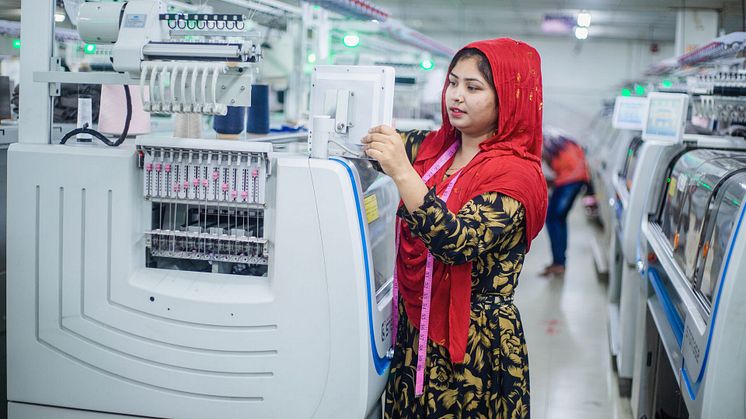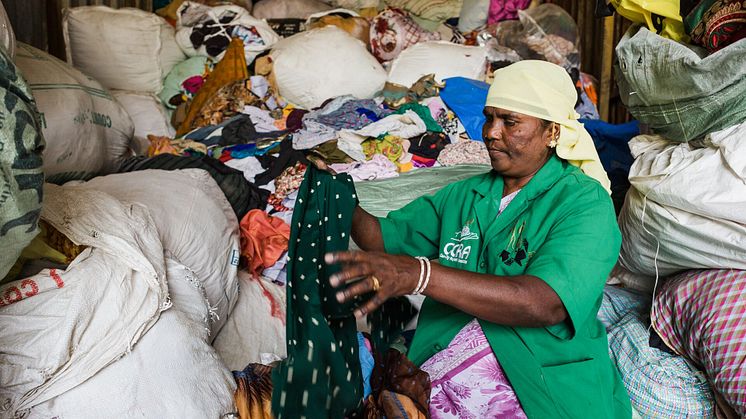
Blog post -
How can Panipat lead a just and circular future?
Panipat is one of the world’s largest textile recycling hubs, yet it’s rarely the first place fashion brands look for recycled materials. The supply chain is highly informal, fragmented and opaque, with big gaps in visibility. Apparel-grade recycling exists in pockets but lacks investment and equipment, even though feedstock is abundant.
Along the roadside, streams of coloured run-off from dyeing units, tinted pink and violet, traced their way, silent reminders of how deeply textile production is woven into this city’s everyday life. Trucks unloaded bales of discarded fabric while looms thudded steadily behind metal shutters. All around us, materials were being sorted, shredded, dyed and spun: a choreography of circularity that has existed here for decades, long before the term became part of global sustainability agendas.

What struck us most was not the disorder, but the constant movement. The sense of a living system adapting to survive. Every alley revealed another layer of connection: formal and informal units next to each other, small recyclers working side by side with national suppliers. It was clear that circularity is not a future ambition here, it already happens every day, sustained by thousands whose work remains largely invisible.
Standing there, we felt both humility and urgency. It became clear that the textile industry’s interconnected challenges: high emissions, waste, labour inequities: cannot be solved in isolation. A systems change approach is needed, one that ensures we tackle these challenges holistically, delivering impact for both people and the planet.
The challenge is not to import solutions from elsewhere, but to understand how to strengthen what already works and how to make it fairer, safer, and more resilient for the people whose livelihoods depend on it.
Why we went to Panipat
We travelled to India to explore how inclusive circular solutions could take root in one of the world’s most dynamic recycling ecosystems. For the H&M Foundation, this trip was part of our wider work to support the textile industry in halving greenhouse gas emissions every decade until 2050, in line with the Carbon Law, while promoting a just transition for the people whose livelihoods depend on it. But a just transition is about much more than jobs. It’s about ensuring that people and the planet aren’t collateral damage in our race to reach net zero. As an independent philanthropic foundation we can convene, de-risk and share insights so others can scale solutions across the value chain.
In this blog post, we explore:
- how circularity already works in Panipat,
- the social and economic dynamics that remain unseen,
- what a just and inclusive recycling ecosystem could look like,
- and how philanthropy and partnership can help strengthen what already exists.

With millions of tonnes of post-consumer textile waste generated each year and a deeply skilled but largely informal workforce, India represents both a challenge and an opportunity for a just and inclusive transition in this part of the value chain.
Panipat, in particular, sits at the heart of this story. The city has long been a global hub for recycled textiles, yet its reputation is often defined by what’s visible: the waste, the pollution, the informality. Beneath that surface lies a complex network of traders, recyclers, spinners, dyers, sorters and community organisations, each playing a role in turning discarded materials into new products. Understanding that ecosystem meant moving beyond numbers and compliance reports to listen to those already reshaping the system from within.
Our goal was not to assess or audit, but to learn. The visit reinforced something we already believed: real systems change does not come from external models, but from partnering with those who live the realities we aim to transform.
What we learned on the ground
Here are three lessons we’re taking forward.
1. Waste needs to be valued
Panipat shows that waste itself is not the problem. What holds the system back is how much of it remains unseen, unregulated and undervalued. Across facilities we saw the same pattern: layers of subcontracting and informal arrangements that make it difficult to trace where materials or responsibilities begin and end. The result is a circular system that functions, but without recognition of those who sustain it.

We met spinners, weavers and recyclers working with skill and precision, yet excluded from the formal narrative of innovation. Recognising and supporting these actors is essential if circularity is to be more than a technical fix. Visibility of workers, of waste streams, of value, must become a design principle, not an afterthought.
2. Informal doesn’t mean unorganised
The local recycling ecosystem operates with a logic of its own. It is fluid, trust-based and remarkably adaptive. Every unit, from family-run business to mid-sized recyclers, plays a defined role in keeping materials in circulation. Panipat functions less like a supply chain and more like an organism constantly shifting, responding and self-organising around opportunity and constraint.
This adaptability is a strength that formal interventions often overlook. Rather than replacing informal systems, we must learn from their efficiency and resilience. The task ahead is to strengthen these networks without erasing the relationships and knowledge that make them work.

3. Circularity without inclusion risks repeating old injustices
Throughout the trip, conversations returned to one central truth: environmental and social goals cannot be separated. Improving recycling processes or scaling new technologies will mean little if the people whose labour underpins the system continue to face unsafe conditions, low pay or exclusion from opportunity.
In Panipat, material loops and worker livelihoods are two sides of the same coin, one cannot thrive without the other. There are concerns about working conditions, the reliance on labour contractors and the lack of basic protections for workers who form the backbone of the industry. Yet we also met organisations already tackling these challenges, linking decarbonisation with worker health, and exploring what a just transition could mean in practice. Their work reminded us that circularity is only credible when it is also just.
What this means for us
Every actor we met in Panipat – from local NGOs and facility managers to brand representatives – is working on a piece of the same puzzle. The opportunity lies in connecting these perspectives to build a more coherent, transparent system. For the H&M Foundation, that means balancing partnership with accountability – defining clear expectations around transparency, safety and fairness, while listening and engaging with respect for local realities.
Our approach focuses on:
- Elevating local expertise and lived experience.
- Designing pilot projects that embed fairness, safety and economic viability from the start.
- Measuring success through impact on people as well as materials.
- Sharing learnings openly so others can scale solutions further.
This same philosophy guides our wider work, from Saamuhika Shakti in Bengaluru – where local NGOs, experts and recyclers co-create circular models with waste pickers – to Oporajita in Bangladesh, which equips women garment workers with future-ready skills to lead the just transition.
Being present matters. Each visit deepens our understanding and helps strengthen the relationships that make long-term progress possible.

What’s next
Panipat’s strength lies not only in what it produces, but in what it can teach. The city could evolve from a sourcing hub into a learning hub for inclusive circularity. Together with partners, we will build on this momentum by focusing philanthropy where it can unlock real systems change – fairer work, cleaner recycling, and stronger local capacity.
But no single actor can deliver this alone. Governments must set the rules, brands must invest for the long term, NGOs must safeguard equity, and philanthropy must act as a catalyst. Circularity will only be sustainable if it is inclusive – and only last if it is collective.
A call to community
Imagine cities like Panipat setting the global standard for circular textile systems – where recycling is visible, safe and valued, and where the people driving it share in its benefits.
We invite partners who share this vision to connect with us. Together, we can turn Panipat into a living example of how inclusive circularity strengthens both communities and the climate.
Let’s learn, build and act – collectively.









